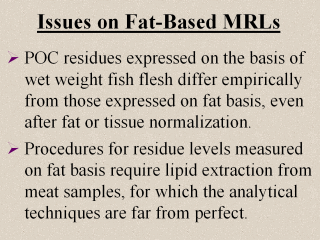 |
Still another
reality for concern here is that pesticide residues expressed on the basis
of wet weight fish flesh are known to differ empirically from those
expressed on fat basis, even after fat or tissue normalization (see,
e.g., Hubert and Ricci, 1981; Borgmann and Whittle, 1991; Hebert and
Keenleyside, 1995). One reason for such an empirical difference is that the
procedures for residue levels measured on fat basis require lipid extraction
from meat samples, for which the various analytical techniques available are
far from perfect (see, e.g., Randall et al., 1998). Among other
things, all lipids are vulnerable to chemical degradation through oxidation
by oxygen, enzymes, and solvent, especially in the presence of untoward
temperature, pH, or light. |
